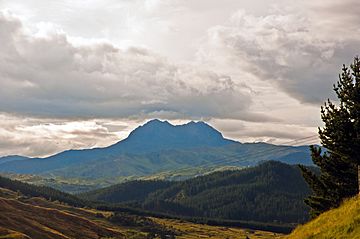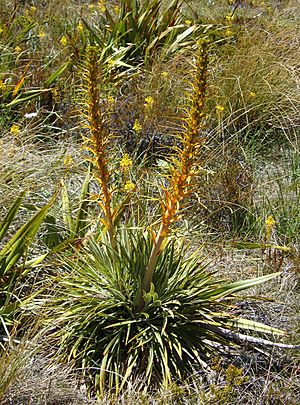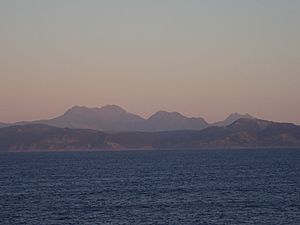Mount Hikurangi (Gisborne District) facts for kids
Quick facts for kids Mount Hikurangi |
|
|---|---|
| Te Ara ki Hikurangi (Māori) | |

Mount Hikurangi, as seen from the Waiapu Valley
|
|
| Highest point | |
| Elevation | 1,752 m (5,748 ft) |
| Listing | List of mountains of New Zealand by height |
| Geography | |
| Location | Gisborne District, New Zealand |
| Parent range | Raukumara Range |
Mount Hikurangi, or Te Ara ki Hikurangi in Māori, is a very tall mountain in the eastern part of New Zealand's North Island. It stands about 1,752 meters (5,748 feet) high. You can find it about 80 kilometers (50 miles) north of Gisborne. It is the highest non-volcanic mountain on the North Island.
Mount Hikurangi is a very special place for the Ngāti Porou people. They are a Māori tribe who live in that area. In Māori mythology, this mountain was the first part of the North Island to appear. This happened when the hero Māui pulled the island up like a giant fish from the ocean. People believe his canoe, Nukutaimemeha, landed on the mountain. It is said to still be there, turned to stone, near the top.
Other mountains nearby include Whanokao (1,428 m), Aorangi (1,272 m), Wharekia (1,106 m), and Taitai (678 m). Together, these mountains create an amazing view. Early Māori explorers often gave New Zealand places names from their homelands. Hikurangi and Aorangi are names that came from places like Tahiti and Rarotonga.
Contents
The First Sunrise of the Day
Mount Hikurangi is traditionally known as the first place in the world to see the sun each new day. This is a special claim, but it depends on the time of year. During the Southern Hemisphere summer, because of how the Earth tilts, it does get the sun's rays earlier than some other places. However, the Chatham Islands and parts of the South Island can see the sun at a similar time.
The Department of Conservation agrees that the mountain is the first point on the mainland to greet the morning sun. The Ngāi Tahu tribe from the South Island even has a special greeting for North Island visitors. It says, "Welcome, O Sunrise!" This refers to Mount Hikurangi.
In the year 2000, Ngāti Porou held big celebrations on the mountain. They welcomed the first dawn of the new millennium. As part of these celebrations, nine huge whakairo (carvings) were put up on the mountain. These carvings tell the story of Māui and his family. Students from Toihoukura, a Māori art school, created them.
History of Mount Hikurangi
Before Europeans arrived, Mount Hikurangi was part of Ngāti Porou's land. The Ngāti Porou people believe they are related to Māui. This means they have felt a connection to the mountain since it first rose from the sea. In the 1870s, the New Zealand government took ownership of the mountain. They made it a state forest park.
However, in November 1990, Mount Hikurangi was given back to Ngāti Porou. Now, they manage the mountain and help people visit it.
Gold Prospecting in the 1800s
In the early days of European settlement, people thought there might be gold on Mount Hikurangi. In 1874, about 100 Māori people looked for gold there. But experts found no real signs of it. Later, in 1886, a man named Reupane te Ana thought he found a huge amount of gold. He told all his friends, and they excitedly collected large amounts of the "precious metal."
It turned out that the metal was not gold at all. It was just a common mineral called mundic. After this, Reupane became known as "Tommy Poorfellow."
Why Mount Hikurangi is Special to Māori
Mount Hikurangi, or Te Ara ki Hikurangi, is very important to the Ngāti Porou people. It holds great spiritual, cultural, and physical meaning for them. It is their most important symbol.
In Māori stories, the mountain was the first part of the North Island to appear. This happened when Māui, an ancestor of Ngāti Porou, pulled the island from the ocean like a giant fish. People believe his canoe, Nukutaimemeha, got stuck on the mountain. It is said to be turned to stone near the top.
Another Ngāti Porou ancestor, Paikea, is also linked to the mountain. A story tells how Paikea survived a great flood sent by his half-brother Ruatapu. Mount Hikurangi became a safe place for people to escape this flood.
The mountain is often mentioned in Ngāti Porou's karakia (prayers), waiata (songs), haka (war dances), and proverbs. Here are some examples:
- Ko Hikurangi te maunga, Ko Waiapu te awa, Ko Ngāti Porou te iwi (Hikurangi the mountain, Waiapu the river, Ngati Porou the people). This is a saying that shows Ngāti Porou's identity.
- Whakaeteete mai ko Hikurangi (Thrusting upward, is Hikurangi). This comes from a haka that celebrates the mountain rising from the ocean.
- Ka rukuruku a Te Rangi-tāwaea i ōna pūeru (Te Rangi-tāwaea [an ancestor] dons his garments). This is said when Mount Hikurangi is covered in snow.
Famous Māori quotes about Hikurangi include:
- Ehara a Hikurangi i te maunga haere (Hikurangi is not a travelling mountain). This quote was used by Te Kani-a-Takirau to explain why he would not leave his home. He was offered the Māori Kingship but turned it down.
Plants and Animals of Mount Hikurangi

The top of Mount Hikurangi is the northernmost place in New Zealand where you can see alpine plants. These are plants that grow in cold, high-altitude areas. You can find large buttercups and prickly wild Spaniards here.
The mountain is also home to a special small shrub called the Hikurangi tutu (Coriaria pottsiana). It only grows on a grassy slope behind the Mount Hikurangi Tramping Hut.
Mount Hikurangi was the last place on the North Island where the North Island saddleback bird was seen in 1910. This bird was later brought back to the North Island in 2002. In the past, kaka birds would get fat eating berries from tawari trees on the mountain. In the 1960s, people thought they heard the call of a kakapo parrot on the mountain. This parrot was last officially seen on the North Island in 1895.
The nearby Raukumara Forest Park has many types of trees. These include rimu, rata, tawa, and totara. Many native birds and animals live in the area. You might see fantails, tui, whio (blue ducks), kaka, and falcons. There are also brown kiwi, Hochstetter's frogs, snails, lizards, and wētā insects.
However, animals brought by humans, like deer, goats, possums, and pigs, can harm the native wildlife.
Visiting Mount Hikurangi
Mount Hikurangi is about 130 kilometers (80 miles) north of Gisborne by road. If you want to visit the mountain, you need to contact Te Rūnanga o Ngāti Porou first. The walking track crosses their private land. Sometimes, the track might be closed for cultural events or farming.
You cannot drive or bike past the car park near the bottom of the mountain. However, you can arrange 4x4 tours to see the carvings through Te Rūnanga o Ngāti Porou. They can also provide a guide for the summit or for an overnight trip.
From the car park, it takes about 7 hours to walk to the top. There is a hut for visitors about 4-5 hours up the mountain. You need to bring your own cooker and water for the hut. You also need to book the hut through Te Rūnanga o Ngāti Porou. Visitors should be careful of the mountain's weather, which can change quickly. It is important to bring clothes for all types of weather.
Hunting of introduced animals is allowed in the nearby Raukumara Forest Park.



